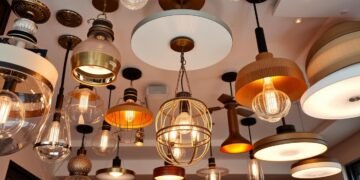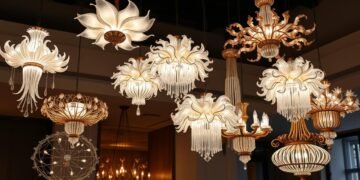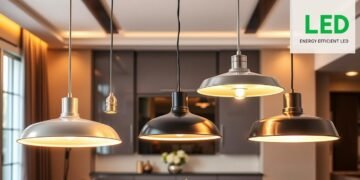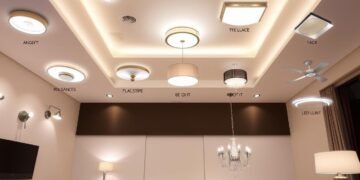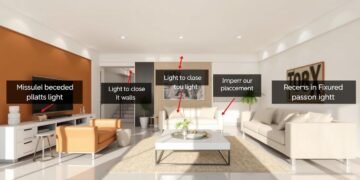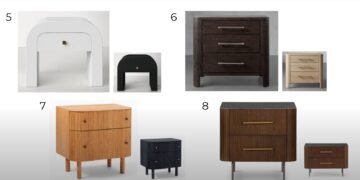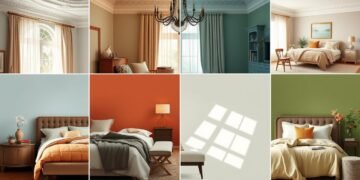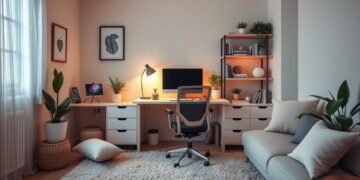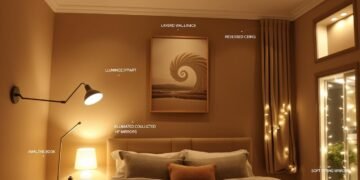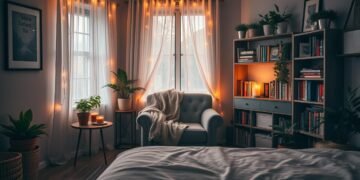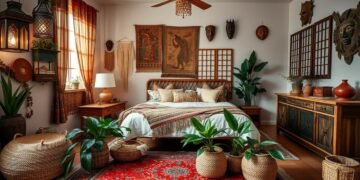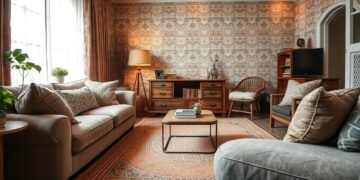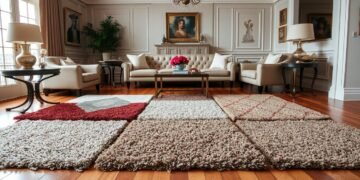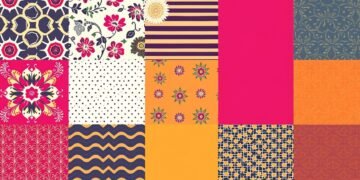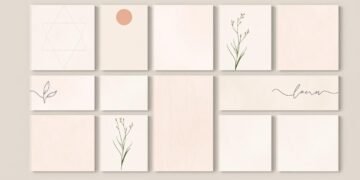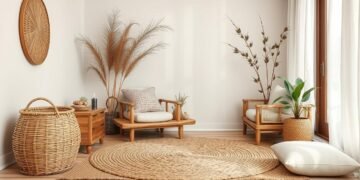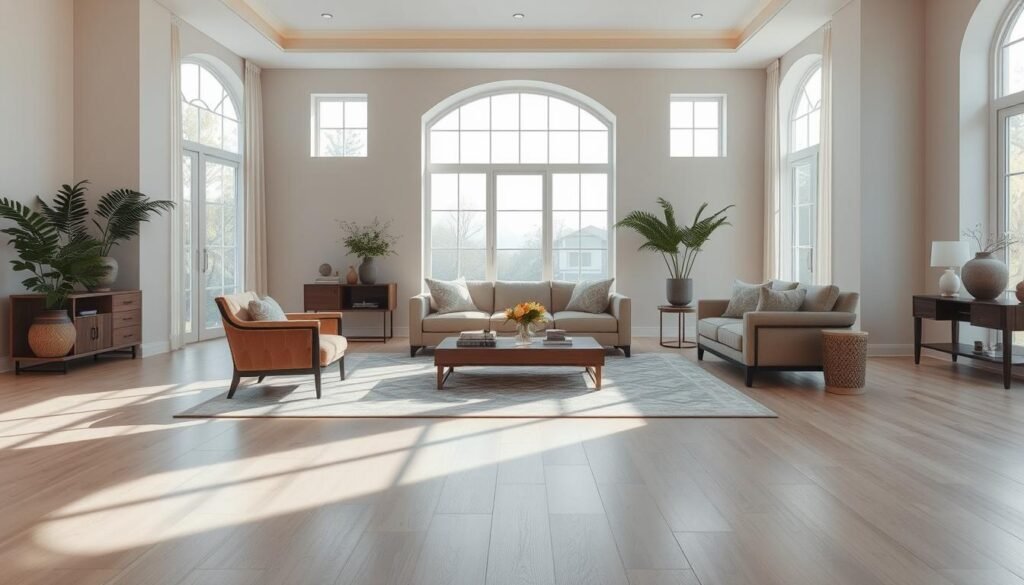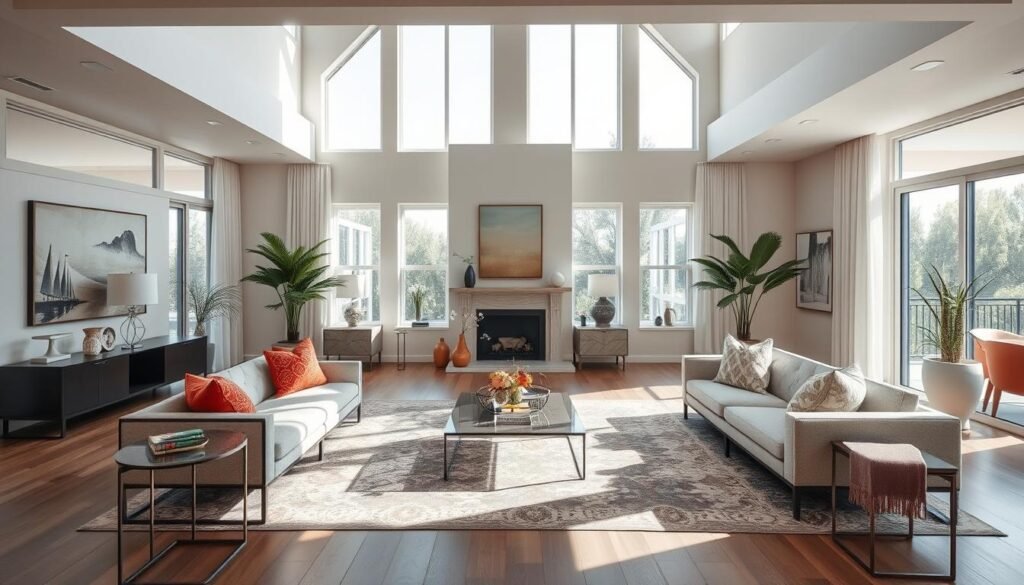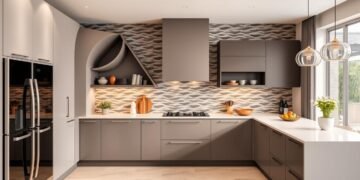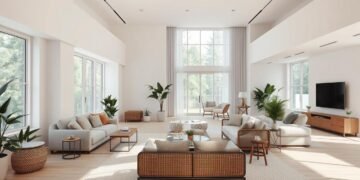Did you know 93% of homeowners say good interior design makes their lives better? This shows how important design is in our daily lives. Learning the core principles of design can help you make your home spaces better and more functional.
Interior design is more than picking furniture and colors. It’s a mix of art and science, blending looks with function. The seven key principles are balance, rhythm, harmony, proportion, emphasis, contrast, and function. These are the basics for making spaces that are both beautiful and reflect your style1.
Exploring interior design can make your home stand out. Whether it’s your living room, bedroom, or kitchen, knowing these principles helps. They guide you in choosing the right layout, colors, and furniture.
Table of Contents
- 1 Understanding the Foundation of Interior Design Theory
- 1.1 Relatedarticles
- 1.2 8 Clever Ways to Introduce Rhythm and Movement into Your Décor
- 1.3 The 6 Simple Steps to Create a Harmonious Interior That Flows
- 1.4 5 Proven Tips for Getting Proportion Right in Every Room
- 1.5 The Role of Design Principles in Creating Harmonious Spaces
- 1.6 How Design Elements Work Together
- 1.7 The Impact of Design on Daily Living
- 2 Principles of Design: Essential Elements for Beautiful Interiors
- 3 Mastering Balance in Interior Spaces
- 4 The Art of Proportion and Scale
- 5 Achieving Perfect Harmony in Design
- 6 Rhythm and Movement: Creating Visual Flow
- 7 Incorporating Emphasis and Focal Points
- 8 The Power of Contrast and Unity
- 9 Implementing Design Principles in Different Room Types
- 10 Common Design Mistakes to Avoid
- 11 Conclusion
- 12 FAQ
- 12.1 What are the core principles of interior design?
- 12.2 How does balance affect interior design?
- 12.3 What is the Golden Ratio in design?
- 12.4 How can I create harmony in my interior design?
- 12.5 What is rhythm in interior design?
- 12.6 How can I incorporate emphasis in my room design?
- 12.7 What role does contrast play in interior design?
- 12.8 How do design principles vary across different room types?
- 12.9 What are some common interior design mistakes to avoid?
- 12.10 How can I apply design principles as a beginner?
- 13 Source Links
Key Takeaways
- Interior design principles significantly impact daily living experiences
- Seven key principles form the foundation of successful interior design
- Balance can be achieved through symmetrical, asymmetrical, or radial arrangements
- Proportion and scale ensure harmony between objects and space
- Rhythm creates visual flow through repetition, alternation, and progression
- Emphasis and contrast add visual interest and dynamism to a room
- Functionality is key for meeting the needs of those living there
Understanding the Foundation of Interior Design Theory
Interior design theory is key to making living spaces beautiful. It mixes design basics and visual communication to turn simple rooms into amazing places. The design process carefully considers different elements for a balanced and attractive result.
The Role of Design Principles in Creating Harmonious Spaces
Design principles guide us in making interiors that work well together. They help us through the complex world of looks and function. By using these principles, we can make spaces that look great and feel right. With real estate turnover up by up to 150% this year, good design is more important than ever2.
How Design Elements Work Together
Design elements like color, texture, form, and space come together to make a complete look. The use of 3D programming has made it easier to achieve balance in design2. This tech helps us plan and see how elements will fit together in a space.
The Impact of Design on Daily Living
A well-designed space can really boost your life. It can change your mood, how productive you are, and your overall happiness. Color psychology is big in design, affecting how people feel in a room2. For example, people often choose dimmer lights in bedrooms and bathrooms for a calm vibe2.
Knowing the basics of design theory lets you make spaces that are not just pretty but also useful and cozy. As you explore interior design, you’ll see how these principles can change any area into a peaceful place.
Principles of Design: Essential Elements for Beautiful Interiors
To make stunning interiors, you need to know the basics of design. The seven main design principles are balance, harmony, rhythm, proportion, emphasis, contrast, and details. These principles help create spaces that look good and work well3.
Balance is key in design. It comes in three types: symmetrical, asymmetrical, and radial. Each type helps spread out visual weight, making a space feel balanced4. Harmony brings everything together, from colors to furniture, making a space look unified yet interesting4.
Rhythm adds movement and flow with repeating elements like color and texture. You can use repetition, alternation, or contrast to achieve this4. Proportion and scale are important for fitting objects together in a room. The ancient Greeks found the secret to pleasing proportions with the Golden Ratio3.
Emphasis highlights certain areas or features in a space. You can use furniture, color, or size to draw attention4. Contrast, made with color or texture, adds interest and defines areas3. Lastly, details make a space unique and personal3.
“Design is not just what it looks like and feels like. Design is how it works.” – Steve Jobs
Learning these design principles can turn any space into a beautiful, harmonious place. It’s all about balancing these elements to make a space inviting and stylish5.
Mastering Balance in Interior Spaces
Creating visual balance in design is key to good interior decorating. It makes your space feel harmonious and comfy. Designers use harmony, balance, contrast, rhythm, and emphasis to get this right6.
Symmetrical Balance: Creating Formal Harmony
Symmetry is a classic way to balance a space. It involves mirroring elements on both sides6. This creates a formal, structured look, great for traditional or elegant spaces. Think of matching nightstands by a bed or identical armchairs by a fireplace.
Asymmetrical Balance: Modern Approaches
For a modern look, try asymmetry in graphic design. This uses different elements with equal visual weight to balance a space6. It’s less strict than symmetry but needs a keen eye. Pairing a large sofa with two smaller chairs and a side table works well.
Radial Balance: Circular Design Elements
Radial balance centers on a point with elements arranged around it. A round dining table with chairs is a great example. This adds interest and movement to your space.
Creating visual balance is more than looks. It’s about making your space feel right. Professional designers use these principles to turn ordinary rooms into stunning, harmonious, and functional spaces7.
“Balance is not something you find, it’s something you create.”
By mastering these balance techniques, you’ll design spaces that look and feel great. Try different approaches to find what suits your style and space best.
The Art of Proportion and Scale
Learning about proportion in graphic design and scale is key for making spaces look good. These elements help create harmony and balance in your home.
Understanding the Golden Ratio
The golden ratio, based on pi, is a math concept artists and designers use for perfect proportions8. It helps make designs that look balanced and pleasing.
Sizing Elements for Your Space
When thinking about design, remember scale is about how we see size in relation to our bodies8. Use this to add interest and depth by mixing life-sized, small, or big elements8.
Creating Visual Weight Distribution
Visual weight is key for balance. Use hierarchical scale to make important things stand out by making them bigger9. Keeping things at human scale makes your space feel normal and comfy9.
| Proportion Type | Effect | Application |
|---|---|---|
| Proportionate | Evokes calm and contentment | Living rooms, bedrooms |
| Disproportionate | Catches attention | Accent pieces, art installations |
| Hierarchical Scale | Emphasizes importance | Focal points, statement furniture |
By understanding these principles of proportion and scale, you can make interiors that look balanced and feel welcoming.
Achieving Perfect Harmony in Design
Harmony in design makes spaces look good and feel right. To get harmony, balance visual elements with goals10. This makes spaces look better, feel better, and match your brand10.
Getting visual harmony means knowing how design parts work together. Colors, shapes, textures, and space are key10. Pick the right parts to make a space that’s both balanced and welcoming.
Keeping design unified and consistent is key for lasting harmony. Set brand rules and design libraries for a consistent look10. This creates a design that speaks to your audience.
“Design is not just what it looks like and feels like. Design is how it works.” – Steve Jobs
Here are some tips to boost your design harmony:
- Use Adobe Illustrator for color harmony guidance10
- Explore Pinterest for fresh design inspiration10
- Collaborate with stakeholders to align creative directions with business goals10
- Implement iterative design refinement processes10
Remember, perfect design harmony is a journey. Keep applying these tips and embracing new ideas. You’ll make spaces that are beautiful and work well.
Rhythm and Movement: Creating Visual Flow
Rhythm and repetition are essential in design. They make your space look good and feel welcoming. By using these principles, you can make your home a place of harmony and interest.
Repetition in Design Elements
Repetition is a strong design tool. It means using the same colors, patterns, or materials over and over. This makes your home easy to move around in and feels like home11.
For instance, using the same color in pillows, art, and rugs can unite a room. It’s like wearing the same color from head to toe.
Progressive Patterns and Sequences
Progressive rhythm means changing the size or intensity of design elements slowly. This movement guides your eye through the space. Constantin Brancusi’s “Bird in Space” is a great example of this, with shapes getting more complex12.
In your home, you can arrange items from smallest to largest on a shelf. This creates a flow from one item to the next.
Transitional Design Features
Using movement in design is key for smooth transitions between areas. Features like archways or open floor plans help guide the eye. They make your home feel connected.
Remember, our eyes move in patterns like the F-pattern or Z-pattern13. Place design elements to follow these patterns. This will help create a natural flow in your home.
Incorporating Emphasis and Focal Points
Emphasis is key in interior design. It’s about making focal points that catch the eye and help balance your space. By learning design emphasis techniques, you can make any room lively and unified14.
Creating Statement Features
To make focal points, think about bold artwork, smart furniture placement, or unique architectural details. The Rule of Thirds, from photography, suggests placing key elements at the 3×3 grid intersections for balanced yet focused designs15. This method helps arrange standout pieces well.
Using Color for Emphasis
Color is a strong tool for emphasis. Our eyes notice color before shape or text, making it great for grabbing attention15. Use contrasting colors to highlight, with a small bold hue often better than big areas of bright color. An accent wall in a bold color can be a room’s focal point, standing out with enough contrast15.
Architectural Focal Points
Architectural features can naturally be focal points in your space. Use spotlights or picture lights to frame objects and focus on them15. Remember, placing items centrally in a room or on a wall naturally draws the eye to them15.
| Emphasis Technique | Description | Effect |
|---|---|---|
| Color Contrast | Using bold, contrasting colors | Draws immediate attention |
| Lighting | Strategic use of accent lighting | Highlights specific areas or objects |
| Texture | Incorporating tactile elements | Creates visual and physical contrast |
| Rule of Thirds | Positioning elements on a 3×3 grid | Balances emphasis across the space |
By understanding and using these design emphasis techniques, you can make your interiors stand out. Remember to balance color, use negative space, and consider architectural features for a harmonious and engaging design1614.
The Power of Contrast and Unity
Contrast in art and design brings life to your spaces. It creates visual intrigue and excitement. You can use color contrasts, mix geometric patterns with organic shapes, or blend modern with vintage. Color contrast is very powerful, making key elements stand out in your design17.
Unity and consistency in design make all elements work together. This creates a cohesive theme in your interior18. By balancing contrast and unity, you can make spaces that are both striking and well-designed.
Using variety in visual design keeps things interesting. Try scaling elements differently to highlight important parts of your space. Mix geometric forms with organic shapes for more visual appeal17.
“Design is not just what it looks like and feels like. Design is how it works.” – Steve Jobs
Good design principles can greatly change how people see your space. A well-designed interior shows trust, professionalism, and credibility17. In fact, 94% of people notice a space’s look and feel first before engaging with it. This shows how key these design principles are19.
By carefully using contrast and unity in your design, you can make spaces that are visually appealing. These spaces will resonate with those who see them, leading to positive results in how your home or office is seen and enjoyed.
Implementing Design Principles in Different Room Types
Design principles are key in making spaces look good and work well. Each room needs its own special way of being laid out and looking. Let’s see how to use these principles in different rooms.
Living Room Design Strategies
Your living room is the heart of your home. To make it welcoming, focus on balance and what catches the eye. You can arrange furniture in a symmetrical or asymmetrical way20.
Use a big piece of art or a fireplace as a focal point. This will draw the eye and add emphasis21.
Bedroom Balance and Harmony
In bedrooms, harmony is essential. Pick colors that help you relax. The bed should be the main focus, with other things supporting it.
Use patterns in bedding or curtains to add rhythm21. Make sure your furniture fits the room well for a balanced look.
Kitchen and Dining Space Flow
Kitchens and dining areas need to flow well and be functional. Use the work triangle concept for the stove, sink, and fridge. Mix light and dark colors, like light cabinets with dark countertops, for interest21.
In dining areas, a central table with furniture arranged around it can make the space feel welcoming20.
| Room Type | Key Design Principle | Application |
|---|---|---|
| Living Room | Balance | Symmetrical or asymmetrical furniture arrangement |
| Bedroom | Harmony | Cohesive color palette and rhythmic patterns |
| Kitchen | Flow | Efficient work triangle and contrasting elements |
Using these design principles in your home makes spaces look great and work well. Paying attention to small details like cushions and accessories can really make your design pop21.
Common Design Mistakes to Avoid
When starting with design, it’s key to avoid common mistakes. Many beginners put too many elements in their designs. This makes the message hard to understand and confuses people22. It shows they don’t fully grasp graphic design basics.
Choosing the wrong fonts is another big mistake. Using too many fonts or ones that don’t go together can make your design look messy23. Use only one or two fonts that work well together. This keeps your design clean and professional.
Color choices can also trip up beginners. Bad color choices can make people feel the wrong way and weaken your design22. Learn about color theory and pick colors that support your message. Also, make sure to use the right color mode for your project – CMYK for print and RGB for digital23.
Ignoring visual hierarchy is another mistake that leads to messy designs23. Make sure your text and images have a clear order of importance. This helps viewers understand your design better. It’s a key part of making balanced and effective designs.
Lastly, don’t try to fill every space. Using white space makes your design look cleaner and more elegant23. Remember, in design, sometimes less is more. By avoiding these mistakes, you’ll create better and more polished designs.
Conclusion
Learning the principles of design is key to making amazing interiors. These principles help turn any space into a beautiful and useful place. Balance, proportion, harmony, and rhythm are the main ideas in interior design theory24.
Each principle has its own role in designing your space. Balance keeps things stable, while proportion makes things feel right together. Harmony brings everything together, and rhythm leads your eye through the design. These work together to make spaces that look good and work well for everyday life25.
Interior design is both art and science. It needs creativity, feeling, and a good understanding of design basics. As you use these principles in your work, feel free to try new things and find your own style. With time and effort, you’ll get better at making spaces that show off your vision and improve the lives of those who use them.
FAQ
What are the core principles of interior design?
How does balance affect interior design?
What is the Golden Ratio in design?
How can I create harmony in my interior design?
What is rhythm in interior design?
How can I incorporate emphasis in my room design?
What role does contrast play in interior design?
How do design principles vary across different room types?
What are some common interior design mistakes to avoid?
How can I apply design principles as a beginner?
Source Links
- 7 Principles of Interior Design: Basics & Key Design Elements
- 7 Elements and Principles of Interior Design & Basic Concepts – Foyr
- The 7 Basic Principles of Interior Design | Kathryn Interiors | Interior Design
- How to Apply the 6 Principles of Design in Interior Design – HOUSE of GOSSAMER
- Principles & Elements Of Interior Design Pt 1 l Residential Interior Decorator l Portland, Lake Oswego, Beaverton & Hillsboro
- Mastering the Principles of Design in Interior Spaces. – Nilesh Sawant
- Mastering Balance: A Guide to Scale and Proportion in Interior Design – Landry Designs
- Principles of Design: Scale and Proportion
- 3.3: Principles of Design- Scale and Proportion
- Balancing Creativity and Strategy to Achieve Design Harmony
- Principles of Design Rhythm |Design Inspiration | Page Flows
- Rhythm in Art — Principles, Types & Techniques
- Design Principles: Compositional Flow And Rhythm
- Emphasis in Interior Design: Key Techniques & Examples
- Mastering Emphasis in Interior Design: A Comprehensive Guide
- The 7 Principles Of Art
- Key Principles of Graphic Design: Balance, Contrast, and Unity
- Principles of design | InVision
- Unity Principle of Design: A Comprehensive Guide
- Library Guides: Design Fundamentals: Elements & Principles
- The 7 Principles of Interior Design
- 10 common design mistakes and how to avoid them | Toast Design Services
- 10 Common Graphic Design Mistakes To Avoid – Zeka Design
- 7 Principles Of Design & How To Use Them in 2024
- Principles of Design: The Cornerstone of Visual Communication | BairesDev
